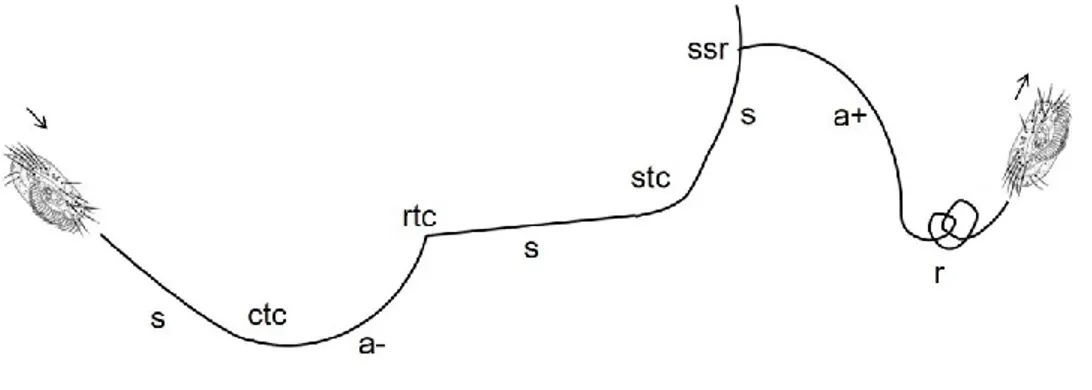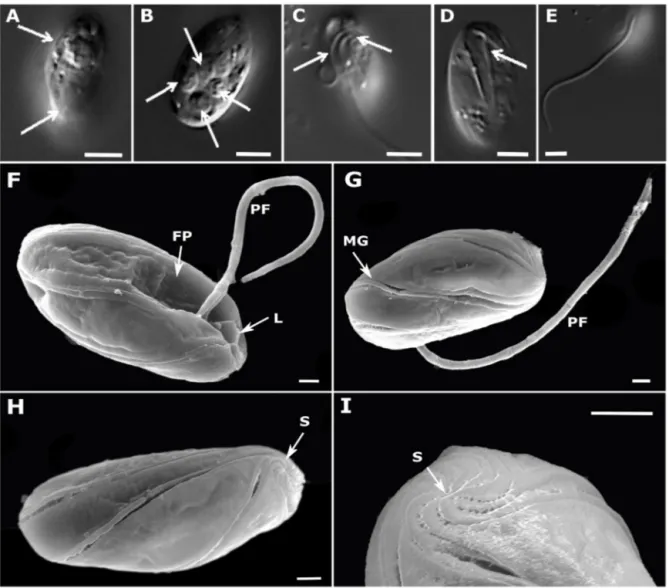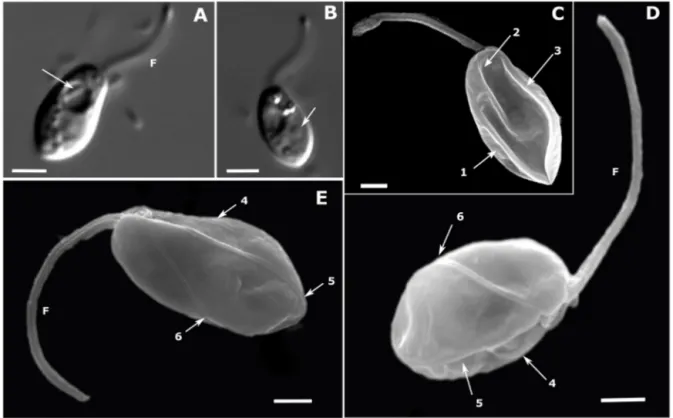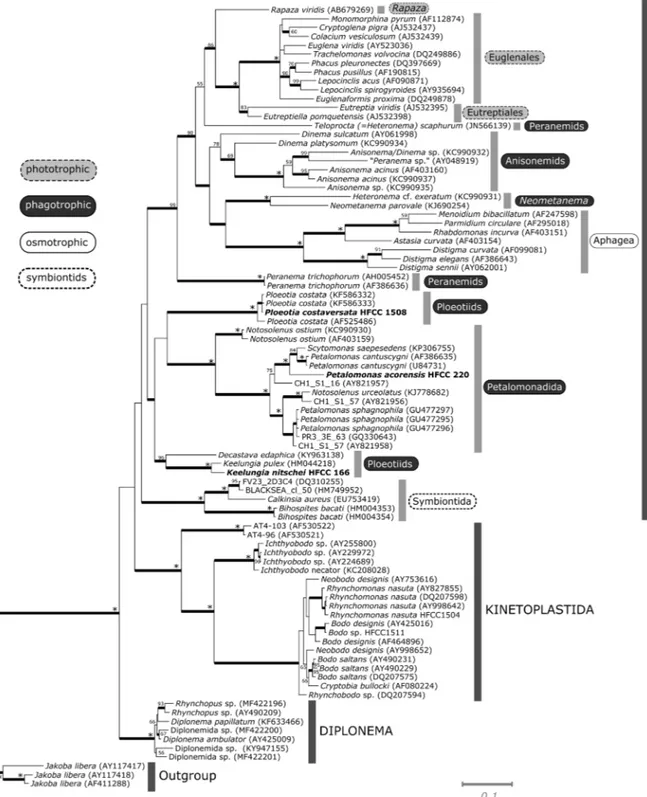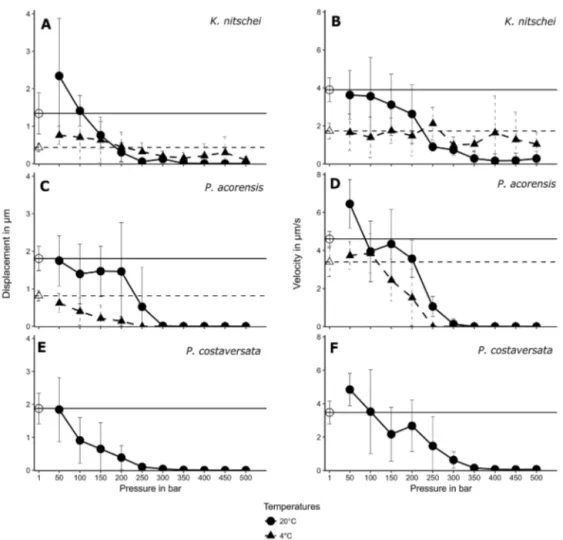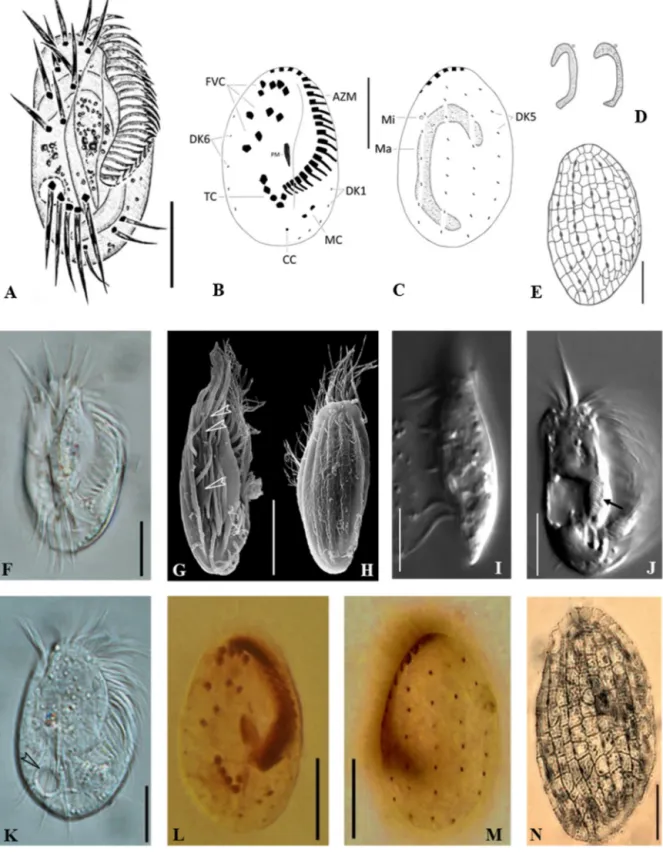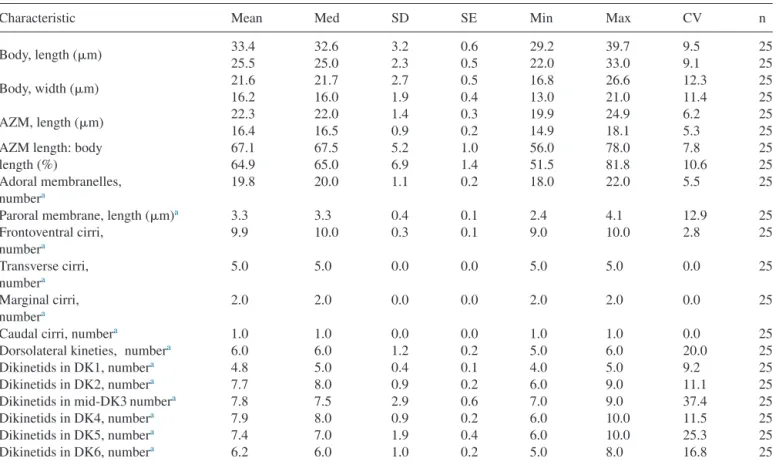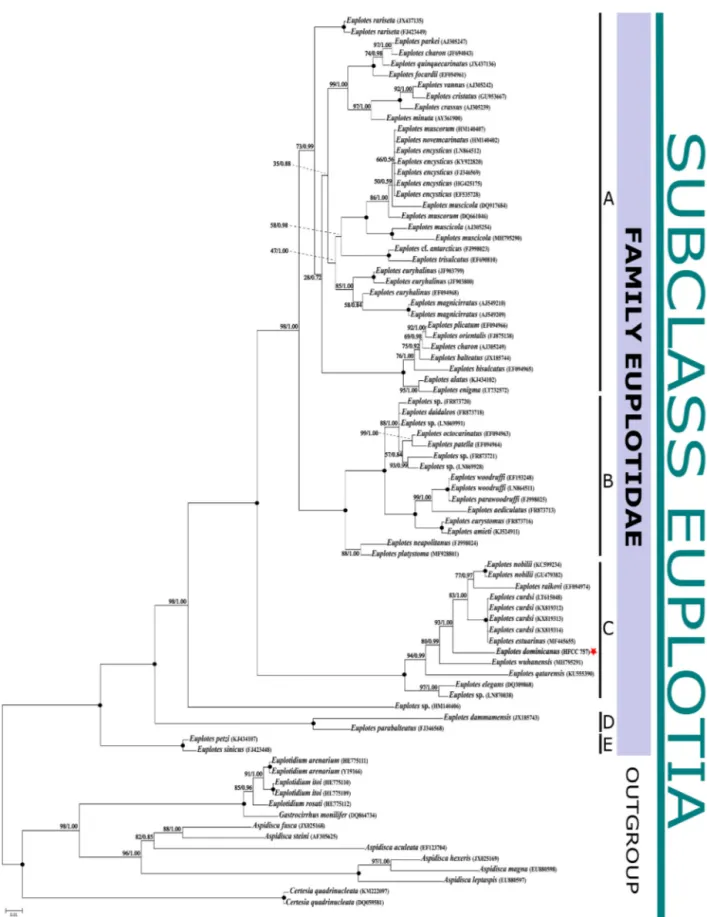Influence of hydrostatic pressure on deep-sea protists
I n a u g u r a l - D i s s e r t a t i o n
zur
Erlangung des Doktorgrades
der Mathematisch-Naturwissenschaftlichen Fakultät der Universität zu Köln
vorgelegt von
Suzana Živaljić aus Zadar, Kroatien
Köln, 2020
Berichterstatter / in: Prof. Dr. Hartmut Arndt PD Dr. Kathrin Lampert
Vorsitz der Prüfung: Prof. Dr. Frank Schäbitz
Beisitzer: Dr. Frank Nitsche
Tag der mündlichen Prüfung: 16.01.2020
“What is essential is invisible to the eye.”
(Antoine de Saint-Exupéry, The Little Prince)
UNIVERSITY OF COLOGNE
Abstract
Faculty of Mathematics and Natural Sciences
Influence of hydrostatic pressure on deep-sea protists
Although the abyssal seafloor represents the most common benthic environment on Earth, eukaryotic microbial life at abyssal depths is still an uncharted territory. This is in striking contrast to their potential importance regarding the material flux and bacteria consumption in the deep sea. However, deep-sea organisms have to cope with extreme environmental conditions including low food resources, low temperatures, darkness and high pressure, making life more challenging in the deep sea in comparison to surface waters. Despite the vastness of this biotope, most recent studies are based on protists inhabiting the euphotic zone, while deep-sea protistan assemblages remain largely uncharacterized. There are only very few cultures available from protists originating from the deep sea (>3000 m). However, using next generation sequencing technology, a large variety of protist genotypes were determined from deep-sea samples. Whether these protists genotypes originate from vital deep-sea populations or from cysts of organisms sedimented down from surface waters is still an unsolved problem.
To contribute to a solution of this problem, we analysed the principal ability of cultivable
surface and deep-sea isolates of heterotrophic flagellates of different phylogenetic groups
(choanoflagellates, ancyromonads, euglenids, kinetoplastids, bicosoecids, chrysomonads, and
cercozoans) to survive exposure to high hydrostatic pressure (up to 670 bar). Obtained results
demonstrated that many different flagellate species isolated from the surface waters and deep-
sea sediments survived drastic changes in hydrostatic pressure. Also, barophilic behaviour was
recorded for several species isolated from the deep sea indicating their possible genetic
adaptation to high pressures. To check the activity of heterotrophic flagellates at high
hydrostatic pressures, the movement of three euglenids strains (Keelungia nitschei,
Petalomonas acorensis, Ploeotia costaversata) was directly observed under different pressures. Theseexperiments showed that the deep-sea strain K. nitschei was better adapted to high hydrostatic
pressures (up to 500 bar) than the two surface strains, P. acorensis and P. costaversata. Also, the
first deep-sea ciliate species, Euplotes dominicanus, could be described in the frame of this study
based on morphology and molecular phylogeny. To our knowledge, this is the first time that a
new ciliate species from abyssal depths of the North Atlantic Ocean (> 4000 m) was isolated,
successfully cultivated and morphologically characterized alive. Metabarcoding data
demonstrate the presence of E. dominicanus in sediments of several deep-sea basins. Further on,
the long-term survival experiments were carried out for
E. dominicanus and two additionaldeep-sea ciliates,
Aristerostoma sp. and Pseudocohnilembus persalinus, up to 430 bar. Someindividuals showed an ability to survive high pressure and to recover (returning to their normal
movement) indicating their barotolerance. In addition, the behaviour of these three deep-sea
ciliates was directly observed under different pressures. The typical behavioural elements for all
three ciliates were observed at least at a pressure of up to 200 bar. This study suggests that
ciliates and heterotrophic flagellates inhabit deep-sea waters and should be an active part of
deep-sea microbial communities.
UNIVERSITÄT ZU KÖLN
Kurzzusammenfassung
Mathematisch-Naturwissenschaftliche Fakultät
Influence of hydrostatic pressure on deep-sea protists
Obwohl der abyssale Meeresboden den größten benthischen Lebensraum auf der Erde darstellt, ist das eukaryotische mikrobielle Leben in den abyssalen Tiefen noch immer sehr schlecht untersucht. Dies steht im krassen Gegensatz zur potenziellen Bedeutung der einzelligen Eukaryoten (Protisten) für den Stofffluss und den Bakterienkonsum in der Tiefsee.
Tiefseeorganismen sind mit extremen Umweltbedingungen wie niedrigen Nahrungsressourcen, niedrigen Temperaturen, Dunkelheit und hohem Druck konfrontiert, was das Leben in der Tiefsee im Vergleich zu Oberflächengewässern schwierig macht. Trotz der Größe des Lebensraums Tiefsee basieren alle bisherigen Studien an Protisten auf Untersuchungen in der euphotischen Zone, Tiefsee-Protisten blieben bisher weitgehend unberücksichtigt. Von Protisten aus großen Tiefen (>3000 m) gibt es nur sehr wenige Kulturen. Metabarcoding Untersuchungen an Tiefseeproben ergaben eine hohe Diversität an Genotypen von Protisten.
Diese können von Protisten, die in der Tiefsee aktiv sind oder von Zysten herrühren, die von Organismen stammen könnten, die sich aus Oberflächengewässern sedimentiert sind.
Im Rahmen der vorliegenden Arbeit wurde zunächst die Fähigkeit heterotropher Flagellaten aus verschiedenen phylogenetischer Gruppen (Choanoflagellaten, Ancyromonaden, Eugleniden, Kinetoplastiden, Bicosoeciden, Chrysomonaden und Cercozoen), die aus Oberflächengewässern und der Tiefsee isoliert wurden, geprüft, ob sie eine Exposition bei hohen hydrostatischen Drücken (bis zu 670 bar) überleben. Die Ergebnisse zeigten, dass viele verschiedene Flagellatenarten drastische Änderungen des hydrostatischen Drucks überstehen.
Außerdem wurde für mehrere aus der Tiefsee isolierte Arten barophiles Verhalten festgestellt,
was auf eine mögliche genetische Anpassung an hohe Drücke hindeutet. Um die Aktivität
heterotropher Flagellaten unter den Bedingungen hohen hydrostatischer Drücke zu überprüfen,
wurde die Bewegung von drei Eugleniden-Arten (Keelungia nitschei,
Petalomonas acorensis, Ploeotia costaversata) direkt unter verschiedenen Drücken beobachtet. Diese Versuche zeigten,dass der Tiefseestamm
K. nitschei besser an hohe hydrostatische Drücke (bis zu 500 bar)angepasst war als die beiden Oberflächenstämme P. acorensis und P. costaversata.
Außerdem wurde eine neue Tiefsee-Ciliatenart,
Euplotes dominicanus, basierend aufMorphologie, und molekularer Identität beschrieben. Nach unserer Kenntnis wurde zum ersten Mal eine Ciliatenart aus den Tiefen des Nordatlantiks (> 4000 m) isoliert, erfolgreich kultiviert und morphologisch charakterisiert. Metabarcoding-Daten belegen das Vorkommen von
E.dominicanus in Sedimenten mehrerer Tiefseebecken. Weiterhin wurden Langzeitexperimente
zum Überleben von
E. dominicanus und zwei weiteren Tiefseeciliaten-Arten, Aristerostoma sp.und
Pseudocohnilembus persalinus (bis zu 430 bar) durchgeführt. Einige Individuen zeigten dieFähigkeit, hohen Druck zu überleben und sich zu erholen (Rückkehr zu ihrer normalen
Bewegung), was auf ihre Barotoleranz hinweist. Darüber hinaus wurde das Verhalten dieser
drei Tiefseeciliaten bei Exposition bei unterschiedlichem Druck beobachtet. Die typischen
Verhaltenselemente konnten für alle drei Ciliatenarten mindestens bis zu einem Druck von 200
bar beobachtet werden. Diese Studie legt nahe, dass Ciliaten und heterotrophe Flagellaten eine
wichtige und aktive Komponente des Abyssals darstellen sollten.
Table of Contents
Abstract………... iii
Kurzzusammenfassung……… v
General Introduction……… 1
Protists in the deep sea……… 1
The effect of pressure on protists………... 3
Aims and hypotheses of the study………. 6
Chapter 1 - Survival of marine heterotrophic flagellates isolated from the surface and the
deep sea at high hydrostatic pressure: Literature review and own experiments………….... 11
Chapter 2 - New phagotrophic euglenids from deep sea and surface waters of the
Atlantic Ocean (Keelungia nitschei, Petalomonas acorensis, Ploeotia costaversata)………. 21
Chapter 3 - A barotolerant ciliate isolated from the abyssal deep sea of the North
Atlantic: Euplotes dominicanus sp. n. (Ciliophora, Euplotia)……… 37
Chapter 4 - Influence of hydrostatic pressure on the behaviour of three ciliate species isolated
from the deep-sea floor………... 52
Conclusive Summary and Perspectives……… 68
References………... 76
Acknowledgements……….. 84
Records of Achievement and Subpublications……….. 86
Erklärung gemäß § 4 Absatz 1 Punkt 9 der Prüfungsordnung……… 88
1
General Introduction
Protists in the deep sea
The deep ocean, usually considered to encompass waters below 200 m, is the largest habitat on our planet by volume and area (Levin et al., 2019). It covers over half of the Earth's surface (Gage and Tyler, 1991). However, the vast majority of oceans remain unseen and unquantified in the face of current and emerging industrial activities and in spite of technologies that have expanded the capability to carry out globally integrated deep-sea observation (Levin et al., 2019). Further deep-sea data limitations are caused by expensive and time‐consuming ship time as well as unfavorable environmental conditions which occur there. The environmental conditions in the deep sea are also characterized as extreme ones, as evidenced by low temperature and food resources, permanent darkness and high pressure. In the benthic abyssal, these environmental conditions are quite uniform. The abyssal sea-floor (3000-6000 m depth, Bruun, 1956) is inhabited by a large variety of macroorganisms that have become evolutionary adapted to this environment by changing their morphology and lifestyle. Up to now, less than 1% of the deep-sea area has been investigated despite the recognition of its high biodiversity (Rex and Etter, 2010). Despite the vastness of this biome, most protistological studies of marine ecosystems are based on protists inhabiting the euphotic zone, while deep‐sea protistan assemblages remain largely uncharacterized (Countway et al., 2007; Schoenle et al., 2017).
Protists are single-celled organisms. They are belonging to the eukaryotes and they possess a
true membrane envelope, eukaryotic ribosomal RNA and endoplasmic membranes. Also, they
have characteristic eukaryotic organelles (mitochondria, chloroplasts and flagella), histones
associated with their chromosomal DNA, the ability to perform phagocytosis and they
generally larger than prokaryotic cells (Fenchel, 1987). Usually, their body size ranges from 2 to
200 µm. Protists are very diverse and present in most terrestrial and aquatic environments
(Triadó-Margarit and Casamayor, 2012; Bates et al., 2013; del Campo and Massana, 2011; Mahé
et al., 2017). They consume bacteria and other protists and they are capable of regenerating
2 nutrients and other inorganic molecules, enhancing the bioavailability of these compounds to other organisms (Fenchel, 1982; Sherr et al., 1983; Caron and Goldman, 1990) which makes them an important part of the microbial food webs (Jürgens and Massana, 2008). In shallow benthic and pelagic marine ecosystems, the importance of protozoan associations in energy transfer through aquatic food webs has been well established (Azam et al., 1983; Alldredge et al., 1986;
Patterson et al., 1993). However, there is emerging evidence that protists form also a very significant part of deep-sea microbial food webs (Atkins et al., 1998, Scheckenbach et al., 2010).
Although primary production is limited to the euphotic zone, delivery of fixed carbon to the deep sea via sinking detritus and carcasses provides a link between surface‐associated and deep‐sea detritus based microbial food webs (Caron et al., 1982; Gooday, 2002; Arndt et al., 2003).
Data for protists recorded from the deep sea are mainly available for foraminiferans (Danovaro et al., 2010; Pawlowski et al., 2011; Gooday and Jorissen, 2012). Due to challenges associated with difficulties of sampling and preservation, there is a huge gap of the knowledge about deep-sea flagellated and ciliated protist communities. However, there are some data based on molecular studies indicating their presence in the deep sea. Thus, environmental DNA surveys based on clonal libraries and next generation sequencing have revealed an enormous genotypical diversity of heterotrophic flagellates collected from the deep sea (López-García et al., 2001; Edgcomb et al., 2009; Scheckenbach et al., 2010; Pawlowski et al., 2011; Salani et al., 2012). Also, a comprehensive analysis of records of genotypes of ciliates from the deep sea (>
1000 m depth) indicated the potential existence of a very large variety of ciliate representatives
of all major phylogenetic groups (Karyorelictea, Heterotrichea, Spirotrichea, Armophorea,
Litostomatea, Phyllopharyngea, Nassophorea, Colpodea, Prostomatea, Plagiopylea,
Oligohymenophorea; Schoenle et al., 2017). A few protists have been isolated from the deep sea,
indicating possible adaptations to extreme deep-sea habitats. Whether records of protist
genotypes from the deep seafloor might originate from sedimented material from the euphotic
surface waters and whether they may grow under deep‐sea conditions is still unknown.
3
The effect of pressure on protists
Up to now, there is not yet enough data on the degree of barophily among deep-sea communities because often these species are difficult to cultivate with present methodologies.
Despite these difficulties, there are few cultures successfully obtained from the deep sea and later on used for the experiments. These experiments are mostly performed using closed pressure vessels where a direct observation is not possible (Turley et al., 1988, 1993; Atkins et al., 1998; Morgan-Smith et al., 2013). Turley et al. (1988) found a barophilic (better growth at high pressure) bodonid flagellate isolated from 4500 m depth. This flagellate grew at 450 bar and 2°C and did not grow at 1 bar and 2°C, indicating an adaptation to deep‐sea conditions.
Most of the present literature data are based on survival ability of the surface and deep-sea isolates of heterotrophic flagellates and ciliates indicating their barotolerance (Kitching, 1957;
Schoenle et al., 2017, 2019; Živalji
ćet al., 2018). According to Morgan-Smith et al. (2013), some surface isolates of Cafeteria roenbergensis and Neobodo designis were able to survive after exposure to 2°C and 500 bar and even positive growth rates were recorded under these conditions.
Another flagellate (Neobodo curvifilus) was shown to have a wide barotolerance and its reproduction was recorded at pressures of 300 bar; a Cercomonas‐like species isolated from the deep sea only grew at pressures of
≥300 bar (Turley and Carstens, 1991). Furthermore, Atkins et al. (1998) observed that deep‐sea isolates of
Caecitellus parvulus and Rhynchomonas nasuta had ahigher growth rate at higher pressures (up to 300 bar) than their shallow‐water counterparts.
Protists can also form cysts in adverse conditions. A choanoflagellate isolate (Monosiga sp.) was observed to encyst at pressures greater than 50 bar (Atkins et al., 1998). Furthermore, several ciliates belonging to the class Karyorelictea and to the subclasses Suctoria and Peritrichia have been found as epibionts on arthropods collected from the deep sea (Bartsch and Dovgal, 2010;
Sedlacek et al., 2013). However, these samples were preserved with ethanol or formalin, not
providing the possibility of cultivation and live observation of collected deep-sea ciliates and
further ecological experiments. Also, it was shown that deep-sea ciliate strains of
Pseudocohnilembus persalinus and Uronema sp. and one surface strain of P. persalinus were able tosurvive better at 557 bar at lower temperature (2 °C) than at higher temperature (13 °C)
4 (Schoenle et al., 2017). Some surface ciliates species, belonging to the several different phylogenetic groups of Oligohymenophorea, Spirotrichea, Heterotrichea and Prostomatea, were able to survive and some even to recover their normal activity after the exposure at the pressures up to 953 bar (Kitching, 1957).
Aquatic environments are characterized by gradients of temperature and pressure, both of which affect the functioning of biological membranes (Pond et al., 2014). Aquatic animals are often stimulated to higher activity by pressures of about 100 bar, but they are paralyzed or killed by pressures of from several hundred to 1000 bar (Kitching, 1957). Some flagellates and ciliates were shown to be sensitive to hydrostatic pressure (Kitching, 1957; Hemmingsen and Hemmingsen, 1983). Often, the pressure causes the morphology change of the cells. It starts with the creasing of the body surface, and it is accompanied by an expansion of the pellicle and protoplasmic surface. At higher pressures, the protoplasm later separates from the expanded pellicle with the loss of volume of the protoplasm. When the ciliate was exposed to pressure for a longer period, protoplasm sometimes rounds up. Auclair and Marsland (1958) studied the shape stability of two ciliates,
Blepharisma undulans and Paramecium caudatum, under varyingconditions of hydrostatic pressure (up to 689 bar) and temperature (12 °C-25 °C). Cells of
B.undulans became shorter and rounded at higher pressure (480 bar) and lower temperature
(decrease from 25 °C to 12 °C). The same pattern was observed for
P. caudatum at pressuresbetween 275 and 344 bar and temperatures of 20 °C and 25 °C. The mechanisms in protists that can overcome the effect of the high pressure are still unknown. Still, for bacteria it is known that an increase of fluidity of cell membranes by incorporation of unsaturated fatty acids plays a role in the survival at high hydrostatic pressures (DeLong and Yayanos, 1985; Allen et al., 1999).
Bartlett (2002) gives three possible reasons why mono-unsaturated fatty acids are required for
growth at high pressure. The first possibility is explained with the theory of homeoviscous
adaptation, which points out to maintain the membrane within a narrow range of viscosity. The
second is that selective pressure will rather maintain the membrane within a liquid‐crystalline
phase and the third explanation is that permeability to ions (protons or sodium ions) could
drive membrane restructuring in response to pressure. A higher fluidity of membranes has also
5 a positive effect on survival at low temperatures, at least for bacteria (DeLong and Yayanos, 1986). In addition to membrane lipids, membrane proteins and enzymes as well as changes in the DNA structure and function have been implicated as playing an important role in growth at high pressure for bacteria (Bartlett, 2002). Whether these effects are important also for protists has not been studied yet, up to our knowledge. Nevertheless, it is also known that pressure can cause changes in the movement of the protists. For some ciliates (Tetrahymena pyriformis,
Holophrya sp., Colpoda cucullus and Euplotes sp.) a moderate pressures (69-207 bar) causesalready an increase of their locomotor activity, but in general, high pressure depresses flagellar or ciliary movement, and in most cases, all movements stop at 552-965 bar (Kitching, 1957).
Locomotion, the main form of expression of ciliate behaviour, is typically displayed as a trajectory conducted by an individual cell which serves to distribute ciliates in the surrounding space and allows exploration of a new environment (Bohatová and V
ďa
čný, 2018). In the beginnings of studies on the motility and behaviour, an ethogram was used for the detailed description of the behaviour, while today video analysis is mostly used. One of the first scientists, who described the locomotion of several ciliates in details, was Ricci (1990). He described the ciliate behaviour by different elements, but it is not known whether ciliates can perform these elements when exposed to high hydrostatic pressures and what are their potential responses to the stress caused by the increase in pressure.
Fig. 1 Schematic drawing of the short lasting elements (continuous trajectory change, ctc; smooth trajectory change, stc; rough trajectory change, rtc; side-stepping reaction, ssr) and the long lasting elements (linear segment, s; rightward arc, a+; leftward arc, a-) according to Ricci (1990). From other elements, the rotation (r) was shown. The arrow indicates the direction of the movement.
6 The effect of pressure is an important and often overlooked factor in the study of deep-sea ecology (Morgan-Smith et al., 2013). The reason might be because the high hydrostatic pressure is very difficult parameter for imitation in laboratory and laboratory experiments on the effects of hydrostatic pressure on biological organisms are technologically limited. The second reason that there are only a few suitable methods for the isolation and cultivation of deep-sea protists.
This lack of knowledge on protists in the largest biome of Earth has encouraged me to start investigations on protists of the deep seafloor to obtain cultures of deep-sea protists and to study their barophilic and/or barotolerant behaviour to get an idea on the potential role of protists in deep-sea ecosystems.
Aims and hypotheses of the study
The general aim of this dissertation was to increase the knowledge on the survival and activity of protists in the deep sea. Protists activity was studied through the survival and behavioural experiments at different temperatures and pressures. It was unclear before, whether protists from the deep sea are active in the deep or originate from cysts sedimenting down from surface waters. A study on the survival ability of very different heterotrophic flagellates isolated from the deep sea and the surface was done. Furthermore, a modified pressure chamber, which can be used at a high hydrostatic pressure, enabled the observation of the behavioural activities at hydrostatic pressures up to 500 bar (Fig. 2B).
For this purpose, we sampled deep-sea sediment from the North Atlantic Ocean and we were
able to isolate and successfully cultivate heterotrophic flagellates and three ciliate species. Also,
two new species of heterotrophic flagellates were isolated from the surface waters. One ciliate
species has been described, using morphological and molecular methods, as a new barotolerant
species. Using a modified pressure system (Fig. 2A-D), these protists were exposed at different
pressure steps and their behaviour was observed directly under the microscope. Comparison
was made between the behaviour of all species conducted under the high pressures and a
behaviour at atmospheric pressure (control treatment).
7
Fig. 2 A-D Workflow of investigations regarding the pressure tolerance of protists. Pressure system consists of: (A) manual hydraulic pump with the ability of gradually increasing the pressure (up to 600 bar), (B) the chamber with a window for direct observation, (C) inverted microscope, (D) Motion Analyzing Microscope (Keyence, VW‐6000) consisting of a controller and camera unit.The main hypothesis of this thesis is that genotypes recordes from abyssal plains belong to organisms that might be active in the deep ocean or originate from cysts sedimenting down from surface waters. In the next four chapters, the possible answers to this hypothesis are discussed.
Chapter 1 - Survival of marine heterotrophic flagellates isolated from the surface and the deep sea at high hydrostatic pressure: Literature review and own experiments.
In this study, we wanted to analyse the principal ability of cultivable heterotrophic flagellates of
different phylogenetic groups (choanoflagellates, ancyromonads, euglenids, kinetoplastids,
bicosoecids, chrysomonads, and cercozoans) to survive exposure to high hydrostatic pressure
(up to 670 bar). We summarized our own studies and the few available data form literature in
pressure tolerance of flagellates isolated from different marine habitats. We aimed to show that
many different flagellate species isolated from the surface waters and deep-sea sediments
survived drastic changes in hydrostatic pressure. Barophilic behaviour was also recorded for
8 several species isolated from the deep sea indicating their possible genetic adaptation to high pressures. This is in accordance with records of heterotrophic flagellates present in environmental DNA surveys based on clone libraries established for deep‐sea environments.
Chapter 2 - New phagotrophic euglenids from deep sea and surface waters of the Atlantic Ocean (Keelungia nitschei, Petalomonas acorensis, Ploeotia costaversata).
This study aimed to increase the knowledge about the overall diversity and phylogenetic relationships of phagotrophic euglenids. Based on morphological and molecular characteristics, three new phagotrophic euglenid species belonging to the petalomonads (Keelungia nitschei,
Petalomonas acorensis) and ploeotiids (Ploeotia costaversata) were described. Also, it washypothesized whether these euglenids, isolated from the deep-sea and surface habitats, can display behavioural motion at increasing hydrostatic pressure. We aimed to show that the deep-sea strain
Keelungia nitschei was the only strain still moving at high hydrostatic pressuresup to 500 bar at 4 °C, indicating that it is better adapted to high hydrostatic pressure at lower temperatures in comparison with the two isolated surface water strains,
Petalomonas acorensisand
Ploeotia costaversata. Thus, the survival at high hydrostatic pressures indicates that thephagotrophic euglenid K. nitschei might be active in the deep-sea microbial food webs.
Chapter 3 - A barotolerant ciliate isolated from the abyssal deep sea of the North Atlantic: Euplotes dominicanus sp. n. (Ciliophora, Euplotia)
Within this study, we described the new
Euplotes species, isolated from abyssal depths (>4000m) of the North Atlantic Ocean, based on morphology, ciliary pattern and molecular data.
Phylogenetic analyses inferred from 18S rRNA sequences show that
Euplotes dominicanus ismost closely related to
E. curdsi, with a sequence similarity of 97.6%. Survival experimentsshowed that
Euplotes dominicanus was able to survive hydrostatic pressures up to 500 barindicating its barotolerance. Additional, metabarcoding data demonstrate the presence of
E.dominicanus in sediments of several deep-sea basins.
9 Chapter 4 - Influence of hydrostatic pressure on the behaviour of three ciliate species isolated from the deep-sea floor
In this study, we report on the behaviour of the three ciliate species
Aristerostoma sp., Euplotes dominicanus and Pseudocohnilembus persalinus isolated form the deep sea. To our knowledge,these are the first living ciliates isolated from the deep sea (
≥4000 m) and observed at high
hydrostatic pressure. It was hypothesized that these deep-sea ciliates can display the normal
behaviour at high hydrostatic pressure. We showed that all three deep-sea ciliates, performed
the typical behavioural elements at least at a pressure of up to 200 bar. Also, long-term survival
experiments were carried out with all three ciliates exposed to 200, 350 and 430 bar. Several
specimens showed an ability to survive for several days at the highest pressure and to recover
from pressure release (returning to their normal movement) indicating their barotolerance. Our
results suggest that ciliates are active in the deep sea and might be an important part of the
deep-sea microbial food web.
10
11
Chapter 1
Survival of marine heterotrophic
flagellates isolated from the surface
and the deep sea at high hydrostatic
pressure: Literature review and own
experiments
Contents lists available atScienceDirect
Deep-Sea Research Part II
journal homepage:www.elsevier.com/locate/dsr2
Survival of marine heterotrophic fl agellates isolated from the surface and the deep sea at high hydrostatic pressure: Literature review and own experiments
SuzanaŽivaljić, Alexandra Schoenle, Frank Nitsche, Manon Hohlfeld, Julia Piechocki, Farina Reif, Marwa Shumo, Alexandra Weiss, Jennifer Werner, Madeleine Witt, Janine Voss, Hartmut Arndt⁎
University of Cologne, Institute for Zoology, General Ecology, Zuelpicher Str. 47b, 50674 Cologne, Germany
A R T I C L E I N F O
Keywords:
Heterotrophicflagellates Deep sea
Abyssal
Hydrostatic pressure Survival
Barophilic protists
A B S T R A C T
Although the abyssal seafloor represents the most common benthic environment on Earth, eukaryotic microbial life at abyssal depths is still an uncharted territory. This is in striking contrast to their potential importance regarding the materialflux and bacteria consumption in the deep sea. Flagellate genotypes determined from sedimentary DNA deep‐sea samples might originate from vital deep‐sea populations or from cysts of organisms sedimented down from surface waters. The latter one may have never been active under deep‐sea conditions. We wanted to analyze the principal ability of cultivable heterotrophicflagellates of different phylogenetic groups (choanoflagellates, ancyromonads, euglenids, kinetoplastids, bicosoecids, chrysomonads, and cercozoans) to survive exposure to high hydrostatic pressure (up to 670 bar). We summarized our own studies and the few available data from literature on pressure tolerances offlagellates isolated from different marine habitats. Our results demonstrated that many different flagellate species isolated from the surface waters and deep-sea sediments survived drastic changes in hydrostatic pressure. Barophilic behavior was also recorded for several species isolated from the deep sea indicating their possible genetic adaptation to high pressures. This is in accordance with records of heterotrophicflagellates present in environmental DNA surveys based on clone libraries established for deep‐sea environments.
1. Introduction
Although the deep sea covers over half of the Earth's surface (Gage and Tyler, 1991), it remains one of the most unknown and unexplored habitats on Earth due to limited access caused by expensive and time‐consuming ship time as well as extreme environmental conditions.
The abyssal seafloor extends between 3000 and 6000 m (Bruun, 1956).
Deep‐sea organisms have to cope with extreme environmental condi- tions including low food resources, lower temperatures, darkness and high pressure, making life more challenging in the deep sea in comparison to surface waters. Despite the vastness of this biotope, the most studies of marine ecosystems are based on protists inhabiting the euphotic zone, while deep‐sea protistan assemblages remain largely uncharacterized (Countway et al., 2007; Schoenle et al., 2016).
However, there are some exceptions, such as deep-sea foraminiferans, who have received considerable attention because of their geological significance and morphological diversity (Countway et al., 2007;
Pawlowski et al., 2011; Gooday and Jorissen, 2012).
Flagellated protists play an important role in microbial food webs (Jürgens and Massana, 2008). Heterotrophicflagellates (HF) are known as important grazers of bacteria in many aquatic ecosystems (Arndt et al., 2000; Boenigk and Arndt, 2002) with capabilities of regenerating nutrients and other inorganic molecules, enhancing the bioavailability of these compounds to other organisms (Fenchel, 1982; Sherr et al., 1983; Caron and Goldman, 1990). In shallow benthic and pelagic marine ecosystems, the importance of protozoan associations in energy transfer through aquatic food webs has been well established (Azam et al., 1983; Alldredge et al., 1986; Patterson et al., 1993). Although primary production is limited to the euphotic zone, delivery offixed carbon to the deep sea via sinking detritus and carcasses provides a link between surface‐associated and deep‐sea detritus based microbial food webs (Caron et al., 1982; Gooday, 2002; Arndt et al., 2003). Whether all protists from euphotic surface waters can grow under deep‐sea condi- tions is still unknown. According to Morgan-Smith et al. (2013), some
http://dx.doi.org/10.1016/j.dsr2.2017.04.022
Received 31 December 2016; Received in revised form 25 April 2017; Accepted 26 April 2017
⁎Corresponding author.
E-mail address:hartmut.arndt@uni-koeln.de(H. Arndt).
Available online 29 April 2017
0967-0645/ © 2017 Published by Elsevier Ltd.
T
surface isolates ofCafeteria roenbergensisandNeobodo designiswere able to survive after exposure to 2°C and 500 bar (50 MPa) and even positive growth rates were recorded under these conditions.Turley et al. (1988) found a barophilic (better growth at high pressure) bodonidflagellate indicating an adaptation to deep‐sea conditions (450 atm; 2 °C).
Another flagellate (Neobodo curvifilus) was shown to have a wide barotolerance and its reproduction was recorded at pressures of 300 atm; a Cercomonas‐like species isolated from the deep sea only grew at pressures of≥300 atm (Turley and Carstens, 1991). Further- more, Atkins et al. (1998) observed that deep‐sea isolates ofCaecitellus parvulusandRhynchomonas nasutahad a higher growth rate at higher pressures (up to 300 atm) than their shallow‐water counterparts.
Protists can also form cysts in adverse conditions. A choanoflagellate isolate (Monosigasp.) was observed to encyst at pressures greater than 50 atm (Atkins et al., 1998).
Environmental DNA surveys based on clonal libraries and next generation sequencing have revealed an enormous genotypical diver- sity of heterotrophic flagellates collected from the deep sea (Lopez‐Garcia et al., 2001;Edgcomb et al., 2009;Scheckenbach et al., 2010;Pawlowski et al., 2011;Salani et al., 2012). However, for most genotypes it is not clear whether they originate from vital deep‐sea populations or from cysts of organisms sedimented down from surface waters, never being active in the deep sea. Thus, a combination of ecological studies together with molecular surveys is necessary to understand the function of deep‐sea heterotrophicflagellate commu- nities. Here, we present ecological studies on pressure tolerance of different flagellate strains isolated from different marine habitats at different depths to check for their ability to survive exposure to high hydrostatic pressures. These data sets expand the few available studies (e.g., Turley and Carstens, 1991; Atkins et al., 1998; Morgan‐Smith et al., 2013). We aimed to summarize available knowledge on pressure tolerance of HF and to add a significant number of additional experi- ments on strains belonging to a very wide range of taxonomic groups surviving hydrostatic pressure of up to 670 bar.
2. Material and methods
We summarized available studies from literature (Turley et al., 1988; Turley and Carstens, 1991; Atkins et al., 1998;Morgan‐Smith et al., 2013) and compared these with our own studies. The conditions in the experiments were principally similar, though some basic para- meters differed (Table 1).
In general, literature and own studies were carried out in a similar way: deep‐sea and surface water samples were subsampled and cultivated in sea‐water medium (≈34–35 PSU). Monocultures (except for Turley and Carstens (1991), who used mixed cultures) were established and stored for long‐term cultivation at atmospheric pres- sure. Before performing pressure experiments, cultures were pre‐culti- vated at the respective experimental temperature until flagellates reached the exponential growth phase. Except in experiments done by Morgan-Smith et al. (2013), cultures were not acclimated to the experimental temperature and they used a continuous-flow chemostat to grow the flagellates in high density. Experimental cultures were enriched by autochthonous bacteria using additions of organics (cereal grains or glucose) or direct additions of bacteria obtained from cultures (Pseudomonas putida,Holomonas halodurans). In all experiments, it was assumed that food concentrations forflagellates were high enough to ensure ad libitum conditions. To determine whether heterotrophic flagellates (HF) were able to survive or even grow at experimental conditions, HF abundance was determined in subsamples taken from the experimental vessels and control vessels at the beginning, daily and at the end of experiments. The number of replicates (experimental vessels) varied between 3 and 14. Exposure to the experimental hydrostatic pressure was conducted in two ways: experimental vessels were exposed either directly to the final experimental pressure (end point; EP, seeTable 1) or via different steps (time point; TP), and HF
abundance and survival were analyzed after each step. In the latter, experimental vessels were released from pressure and exposed to the next higher pressure immediately after subsampling. Atkins et al.
(1998) showed that time point experiments revealed a pressure tolerance of HF lying in the same range of end point experiments. In most experiments (seeTable 1), end point sampling was used. Daily sampling, with minimum loss of pressure, was done only in experiments fromMorgan-Smith et al. (2013). Except forTurley et al. (1988)and Morgan-Smith et al. (2013) live‐counting was performed. Control vessels were investigated which were left at atmospheric pressure (all studies except for those byMorgan‐Smith et al., 2013).Morgan-Smith et al. (2013)exposed control vessels at 0.8 MPa (8 bar).
2.1. Origin and cultivation of heterotrophicflagellates (HF)
We collected surface water samples from the Atlantic, Pacific Ocean, and the Baltic Sea. Deep‐sea samples were obtained from different depths using a Multicorer system (Table 1). Samples were collected during different cruises with the research vessels R/VSonne(SO223T, 2012; SO237, 2014/2015), R/V Meteor (ME 71/2, 2007; ME79/1, 2009), and R/VPolarstern(PS 62, 2002). Only corers with undisturbed sediment and overlaying water were used for further analyses. Once on deck, cores were immediately processed. Defined volumes of sediment (2 ml) or surface water (1 ml) were transferred into 50 ml‐tissueculture flasks (Sarstedt, Nümbrecht, Germany) filled with 30 ml autoclaved seawater (35 PSU) and two quinoa grains to ensure growth of autochthonous bacteria. In the home laboratory, monocultures of different species were established by serial dilution or with the help of a micromanipulator (PatchMan NP 2 from Eppendorf, Germany) under an inverted microscope (ZEISS Axiovert 25). Isolated species were cultivated in 50 ml‐tissue‐culture flasks (Sarstedt, Nümbrecht, Germany) filled with 30 ml of autoclaved 35 PSU Schmaltz‐Pratt medium (a liter contained 28.15 g NaCl, 0.67 g KCl, 5.51 g MgCl2x 6 H2O, 6.92 g MgSO4x 7 H2O, 1.45 g CaCl2x 2 H2O, 0.10 g KNO3, and 0.01 g K2HPO4x 3 H2O) and supplied with quinoa or wheat grains as a carbon source for autochthonous bacteria. Long‐term cultivation con- ditions were 10 °C at 23‐35 PSU.
2.2. Pressure experiments
Experiments on pressure tolerance of HF were carried out with a pressure generating system at pressures of up to 670 bar. The system consisted of three stainless steel pressure chambers (ø 30 mm, depth 50 mm) and a pressure pump with a transfer ratio of 1:400 bar (SITEC M 189‐2 L, AMATIC‐DIETRICH GmbH). Experimental cultures were adapted for two weeks either to 2 °C (deep sea of Atlantic), 13 °C (deep sea of the Mediterranean) or 20 °C (room temperature). To ensure unlimited food conditions, cultures were provided with quinoa, wheat or canola grains (long‐term experiments) or with a glucose solution (3 ml of 2 g l‐1 glucose added to 30‐ml‐batch culture; short‐term experiments) to support growth of coexisting bacteria. One set of experiments (undetermined choanoflagellate HFCC 824) was carried out with a direct addition of bacteria (Pseudomonas putida).
We exposed isolatedflagellate strains either directly (end point; EP) or stepwise (time point; TP) to different hydrostatic pressures. In experiments exposed to a direct increase of hydrostatic pressure (EP), all samples were observed at the beginning and after a period of 1 to 7 days of exposure to different pressures ranging from 50 to 670 bar. The pressure was established within a few minutes. In the other sets of experiments, a stepwise increase of pressure (TP) was applied (Table 1).
Flagellates were exposed to pressure in total for 6 or 7 days and were decompressed every two days for taking subsamples and were then exposed to higher pressure again. Survival of the flagellates was recorded when the active movement of flagella was observed after exposure to a given hydrostatic pressure.
All experiments were run with 3‐10 replicates. The same number of
Table 1
List of species (literature and own studies) used for pressure experiments. Strain number, origin of strains and experimental conditions are given. Experimental conditions included experimental temperature, exposure time, applied pressure as well as the kind of pressure experiment (end point (EP) or time point (TP)). Number of replicates (N) in experiments, the experimental volume and an indication which type of food was provided is also given. The pressure at which survival could be observed is marked in bold. Strains which were studied at different experimental conditions are marked with one to three asterisks (*). Underlined strains were investigated by Turley et al. (1988), Turley and Carstens (1991), Atkins et al. (1998) and Morgan-Smith et al. (2013). For further information on the sampling location and depth etc. seeTable S1.
Taxonomy Strain Isolate Exp. Exp. time Pressure [bar] EP/TP N Exp. volume Added food Author
origin temp.
[⁰C]
[h] [mL]
(depth [m]) Choanoflagellate
Undet.
choanoflagellate
HFCCh164 Atlantic (5756) 20 20 500 EP 4 2.16 + glucj This study
Undet.
choanoflagellate
HFCC 199 Atlantic (0) 20 20 460 EP 4 2.16 + gluc This study
Monosigasp.a BSZc6 Pacific (2500) 20 144 50, 100, 150, EP 3 10 +H.h.k Atkins et al., 1998
200, 250, 300 Undet.
choanoflagellate
HFCC 824 Pacific (5276) 13 144 250,350,450,550 EP 8 0.6 + grainl This study
Undet.
choanoflagellate
HFCC 824* Pacific (5276) 13 144 250,350,550 EP 4 0.6 +P.p.m This study
Undet.
choanoflagellate
HFCC 824** Pacific (5276) 13 144 350,550 TP 4 0.6 +P.p. This study
Undet.
choanoflagellate
HFCC824*** Pacific (5276) 13 144 350,450,550 TP 8 0.6 + grain This study
Ancyromonads
Ancyromonassp.a BRMb2 Pacific (2500) 3.5 144 50,100,150, EP 3 10 +H.h. Atkins et al., 1998
200, 250, 300 Euglenids
Keelungiasp. HFCC 166 Atlantic (5117) 20 20 540 EP 4 2.16 + gluc This study
Kinetoplastids
Neobodo curvifilus III Atlantic (2665) 5 72 50,100,200,300,
450
EP 2 0.35 + grain Turley and
Carstens, 1991
Bodosp. I Atlantic (4500) 2 528 450 TP 14 160 – Turley et al., 1988
Neobodo designis SCCAPiV ? (0) 2 120–360 500 EP 6 5 + grain Morgan-Smith
et al., 2013
N. designis HFCC 8 Baltic (0) 2 168 50,150, 250 EP 3 0.2 + grain This study
N. designis HFCC 8* Baltic (0) 13 1.5 50,100,150, EP 3 0.2 + grain This study
200, 250, 300
N. designis HFCC 8** Baltic (0) 13 72 50,150,250 EP 3 0.2 + grain This study
N. designis HFCC 8*** Baltic (0) 13 72 50,150,250, EP 10 0.2 + grain This study
350,450,550
N. designis HFCC 110 Mediterranean (2670) 2 168 50,150, 250 EP 3 0.2 + grain This study
N. designis HFCC 110* Mediterranean (2670) 13 1.5 50,100,150, EP 3 0.2 + grain This study
200, 250, 300
N. designis HFCC 110** Mediterranean (2670) 13 72 50,150,250 EP 3 0.2 + grain This study
N. designis HFCC110*** Mediterranean (2670) 13 72 50,150,250, EP 10 0.2 + grain This study
350,450,550
N. designis HFCC 140 Atlantic (5121) 13 1.5 50,100,150, EP 3 0.2 + grain This study
200,250, 300
N. designis HFCC 144 Atlantic (4474) 13 1.5 50,100,150, EP 3 0.2 + grain This study
200,250, 300
Rhynchomonas nasuta BSZc1 Pacific (2500) 20 144 50,100,150, EP 3 10 +H.h. Atkins et al., 1998
200,250, 300
R. nasuta CBRf1 Atlantic (0.5) 20 144 50,100,150, EP 3 10 +H.h. Atkins et al., 1998
200, 250, 300
R. nasuta HFCC 18 Atlantic (0) 2 168 50,150, 250 EP 3 0.2 + grain This study
R. nasuta HFCC 18* Atlantic (0) 13 1.5 50,100,150, EP 3 0.2 + grain This study
200, 250, 300
R. nasuta HFCC 18** Atlantic (0) 13 72 50,150,250 EP 3 0.2 + grain This study
R. nasuta HFCC 18*** Atlantic (0) 13 72 50,150,250, EP 10 0.2 + grain This study
350,450,550
R. nasuta HFCC 99 Atlantic (2484) 13 1.5 50,100,150, EP 3 0.2 + grain This study
200, 250, 300
R. nasuta HFCC 147 Atlantic (5121) 2 168 50,150, 250 EP 3 0.2 + grain This study
(continued on next page)
Table 1(continued)
Taxonomy Strain Isolate Exp. Exp. time Pressure [bar] EP/TP N Exp. volume Added food Author
origin temp.
[⁰C]
[h] [mL]
(depth [m])
R. nasuta HFCC 147* Atlantic (5121) 13 1.5 50,100,150, EP 3 0.2 + grain This study
200,250, 300
R. nasuta HFCC 147** Atlantic (5121) 13 72 50,150,250 EP 3 0.2 + grain This study
R. nasuta HFCC147*** Atlantic (5121) 13 72 50,150,250, EP 10 0.2 + grain This study
350,450,550
R. nasuta HFCC 149 Atlantic (4478) 13 1.5 50,100,150, EP 3 0.2 + grain This study
200, 250, 300
R. nasuta HFCC 171 Atlantic (8346) 20 20 660 EP 3 2.16 + gluc This study
R. nasuta HFCC 173 Atlantic (0) 20 20 670 EP 4 2.16 + gluc This study
Bicosoecids
Caecitellus parvulus EWMd1 Pacific (2500) 20 144 50,100,150, EP 3 10 +H.h. Atkins et al., 1998
200,250, 300
C. parvulus NBHg4 Atlantic (2.5) 20 144 50,100,150, EP 3 10 +H.h. Atkins et al., 1998
200,250, 300
Cafeteria roenbergensis SCCAPiVI ? (0) 2 168–192 500 EP 6 5 + grain Morgan-Smith
et al., 2013
C. roenbergensis HFCC 34 Atlantic (0) 2 168 50,150, 250 EP 3 0.2 + grain This study
C. roenbergensis HFCC 34* Atlantic (0) 13 1.5 50,100,150, EP 3 0.2 + grain This study
200,250, 300
C. roenbergensis HFCC 34** Atlantic (0) 13 72 50,150,250 EP 3 0.2 + grain This study
C. roenbergensis HFCC 34*** Atlantic (0) 13 72 50,150,250, EP 5 0.2 + grain This study
350,450,550
Cafeteriasp. HFCC 114 Mediterranean (2670) 2 168 50,150, 250 EP 3 0.2 + grain This study
Cafeteriasp. HFCC 114* Mediterranean (2670) 13 1.5 50,100,150, EP 3 0.2 + grain This study
200,250, 300
Cafeteriasp. HFCC 114** Mediterranean (2670) 13 72 50,150,250 EP 3 0.2 + grain This study
Cafeteriasp. HFCC 115 Mediterranean (4318) 13 1.5 50,100,150, EP 3 0.2 + grain This study
200,250, 300
Cafeteriasp. HFCC 115* Mediterranean (4318) 13 72 50,150,250, EP 5 0.2 + grain This study
350,450,550
C. roenbergensis HFCC 187 Atlantic (0) 20 20 520 EP 4 2.16 + gluc This study
C. roenbergensis HFCC 803 Pacific (1259) 2 168 200,260 TP 6 0.2 + grain This study
C. roenbergensis HFCC 803* Pacific (1259) 13 168 150,250, 460 TP 7 0.2 + grain This study
C. roenbergensis HFCC 804 Pacific (2687) 2 168 200,260 TP 6 0.2 + grain This study
C. roenbergensis HFCC 804* Pacific (2687) 13 168 150,250,460 TP 7 0.2 + grain This study
C. roenbergensis HFCC 808 Pacific (5497) 13 168 150,250,460 TP 7 0.2 + grain This study
C. roenbergensis HFCC 827 Pacific (2776) 2 168 200,260 TP 6 0.2 + grain This study
C. roenbergensis HFCC 827* Pacific (2776) 13 168 150,250,460 TP 7 0.2 + grain This study
C. roenbergensis HFCC 167 Atlantic (5667) 20 20 460 EP 4 2.16 + gluc This study
Chrysomonads
Undet. Chrysomonad DAe2 Atlantic (1500) 3.5 144 50,100,150, EP 3 10 +H.h. Atkins et al., 1998
200, 250, 300
Undet. Chrysomonad DAe3 Atlantic (1500) 3.5 144 50,100,150, EP 3 10 +H.h. Atkins et al.,1998
200, 250, 300 Paraphysomonas
butcheri
IV Atlantic (2665) 5 72 50,100,200, 300,
450
EP 2 0.35 + grain Turley and
Carstens, 1991
Spumellasp. HFCC 29 Pacific (0) 2 168 50,150, 250 EP 3 0.2 + grain This study
Spumellasp. HFCC 29* Pacific (0) 13 1.5 50,100,150, EP 3 0.2 + grain This study
200,250, 300
Spumellasp. HFCC 29** Pacific (0) 13 72 50,150,250 EP 3 0.2 + grain This study
Spumellasp. HFCC 29*** Pacific (0) 13 72 50,150,250, EP 5 0.2 + grain This study
350,450,550
Spumellasp. HFCC 130 Atlantic (4604) 2 168 50,150, 250 EP 3 0.2 + grain This study
Spumellasp. HFCC 130* Atlantic (4604) 13 1.5 50,100,150, EP 3 0.2 + grain This study
200,250, 300
Spumellasp. HFCC 130** Atlantic (4604) 13 72 50,150,250 EP 3 0.2 + grain This study
Spumellasp. HFCC130*** Atlantic (4604) 13 72 50,150,250, EP 5 0.2 + grain This study
350,450,550
(continued on next page)
